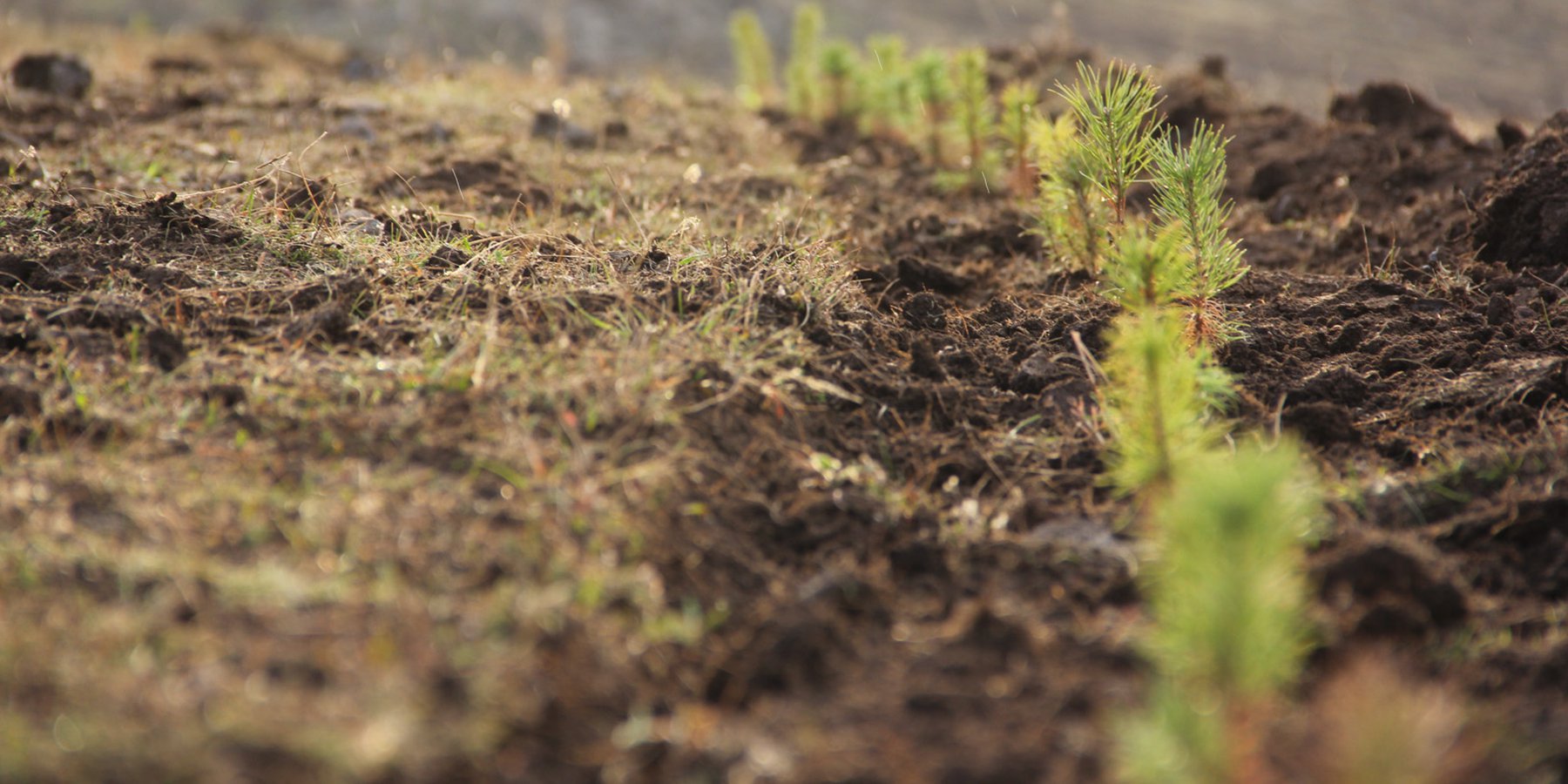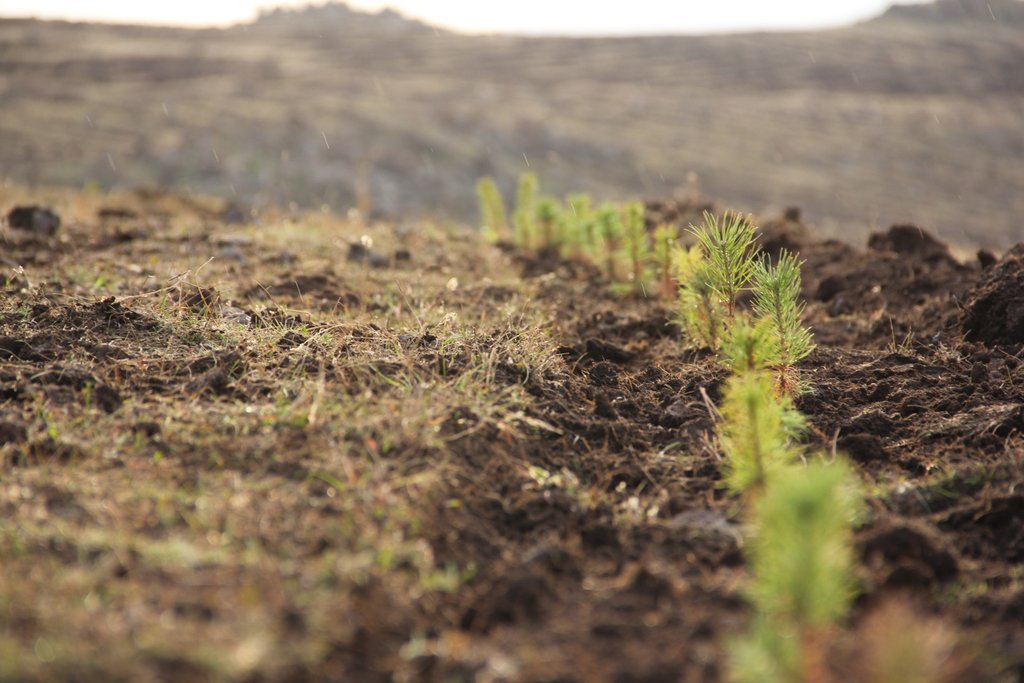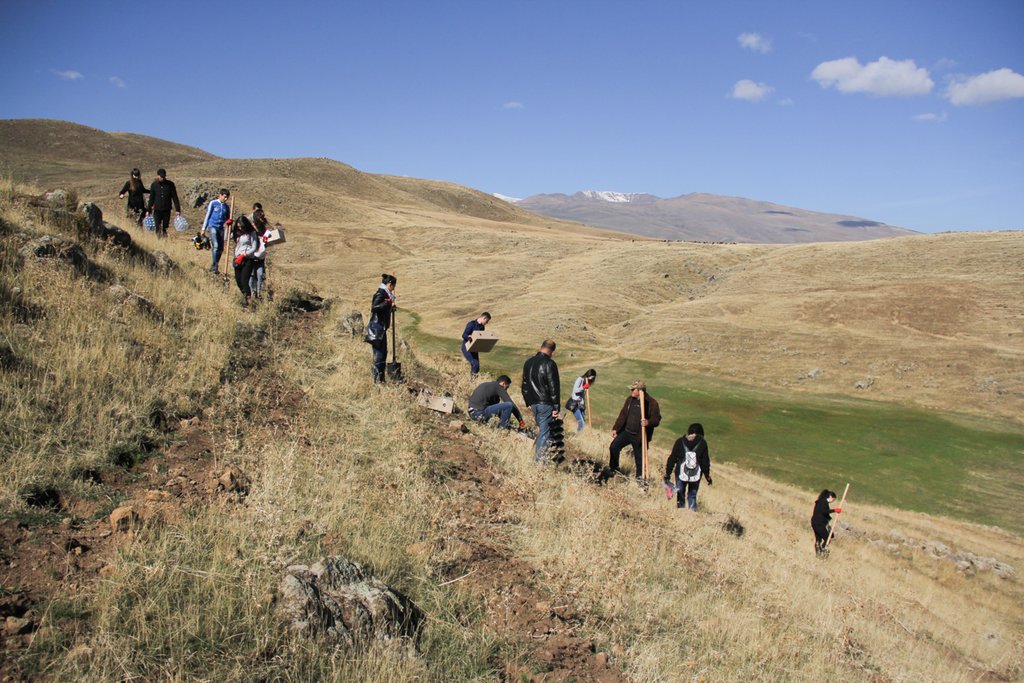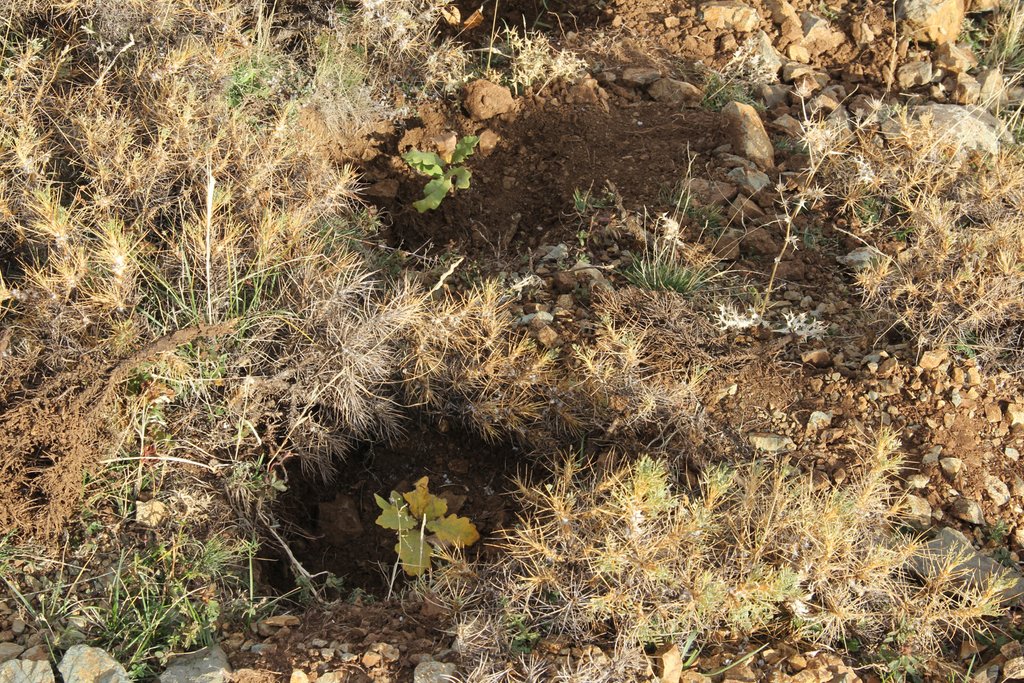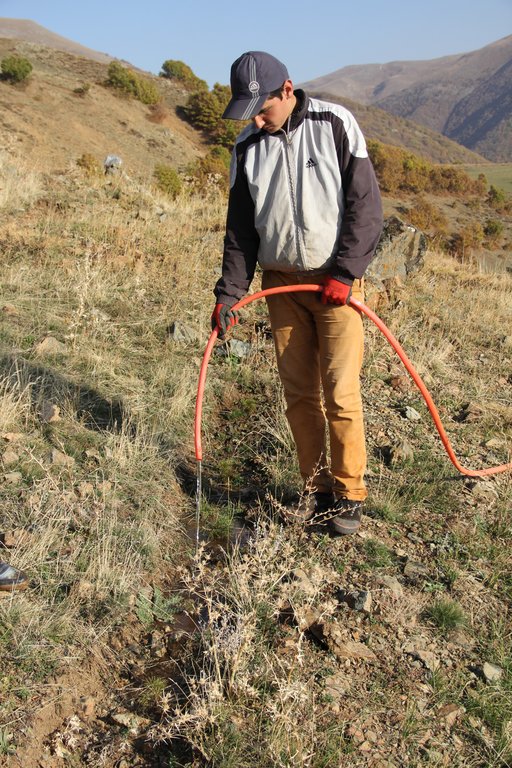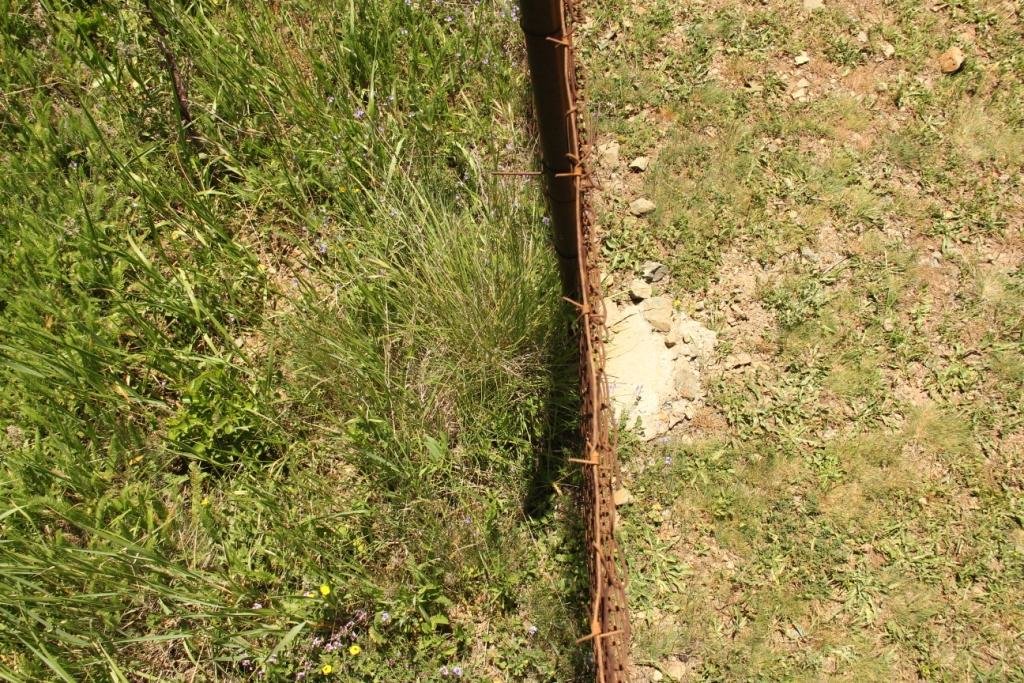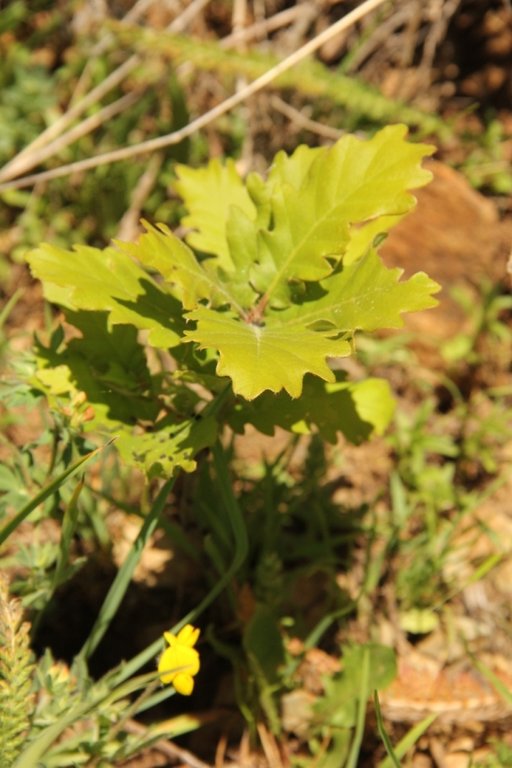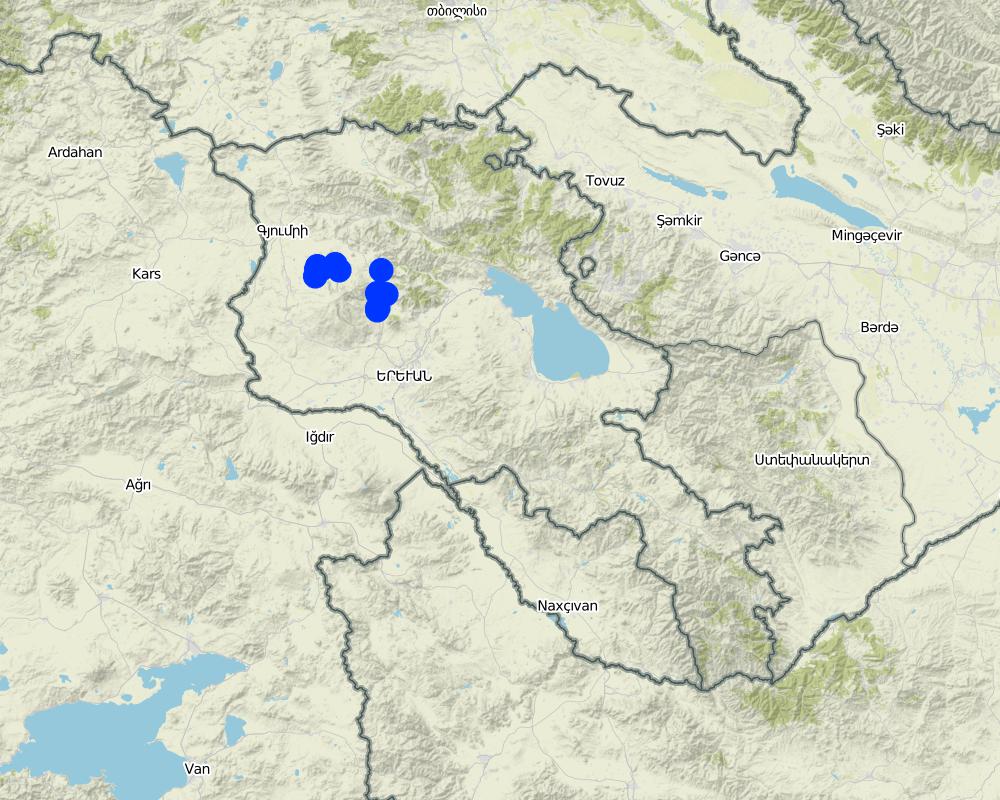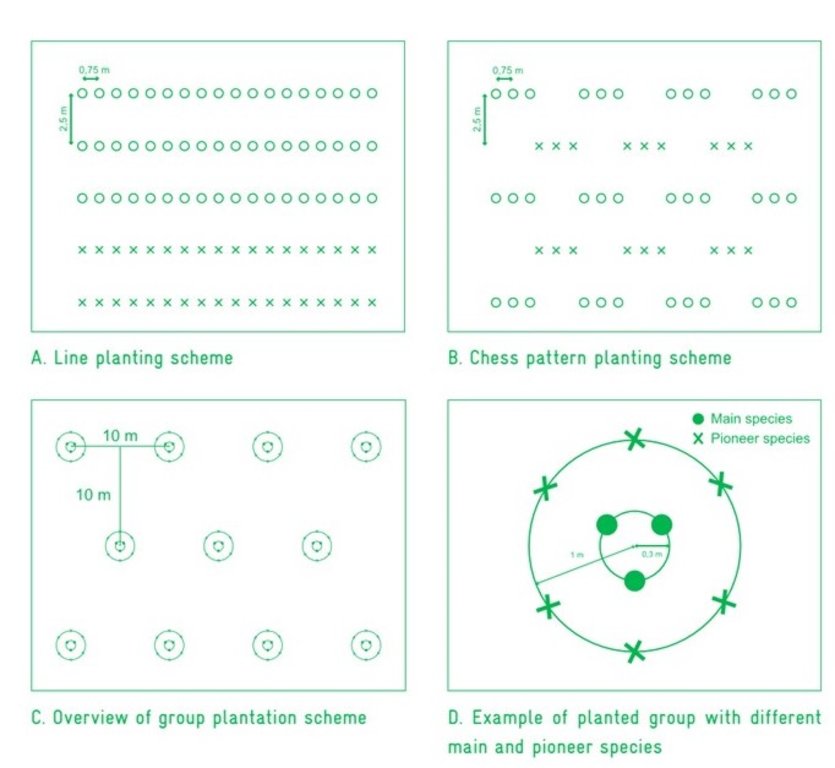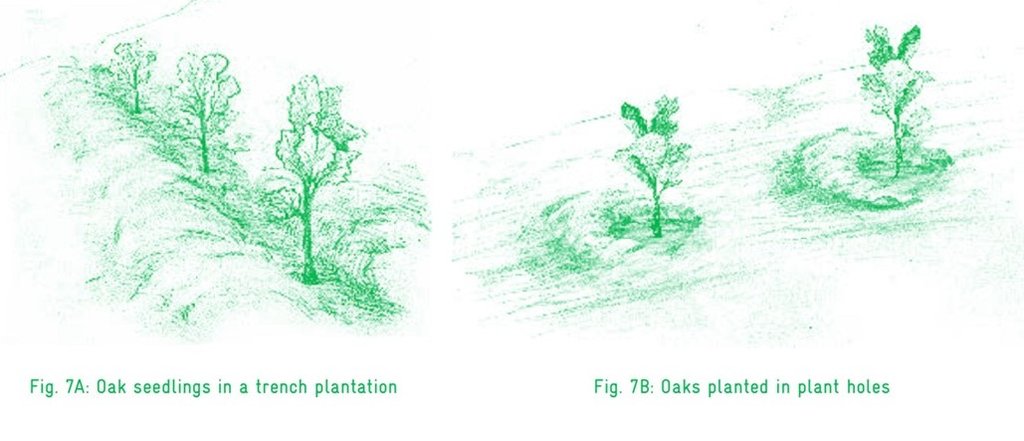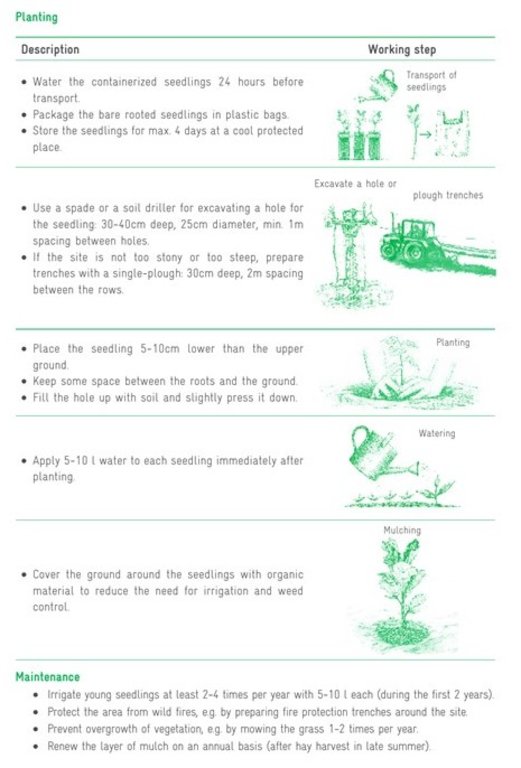High-altitude afforestation for erosion control [ប្រទេសអាមេនី]
- ការបង្កើត៖
- បច្ចុប្បន្នភាព
- អ្នកចងក្រង៖ Hanns Kirchmeir
- អ្នកកែសម្រួល៖ Artur Hayrapetyan
- អ្នកត្រួតពិនិត្យ Ursula Gaemperli
technologies_4101 - ប្រទេសអាមេនី
ពិនិត្យមើលគ្រប់ផ្នែក
ពង្រីកមើលទាំងអស់ បង្រួមទាំងអស់1. ព័ត៌មានទូទៅ
1.2 ព័ត៌មានលម្អិតពីបុគ្គលសំខាន់ៗ និងស្ថាប័នដែលចូលរួមក្នុងការវាយតម្លៃ និងចងក្រងឯកសារនៃបច្ចេកទេស
អ្នកជំនាញឯកទេស SLM:
ឈ្មោះគម្រោងដែលបានចងក្រងឯកសារ/ វាយតម្លៃលើបច្ចេកទេស (បើទាក់ទង)
Integrated Biodiversity Management, South Caucasus (IBiS)ឈ្មោះអង្គភាពមួយ (ច្រើន) ដែលបានចងក្រងឯកសារ/ វាយតម្លៃបច្ចេកទេស (បើទាក់ទង)
Deutsche Gesellschaft für Internationale Zusammenarbeit (GIZ)1.3 លក្ខខណ្ឌទាក់ទងទៅនឹងការប្រើប្រាស់ទិន្នន័យដែលបានចងក្រងតាមរយៈ វ៉ូខេត
តើពេលណាដែលទិន្នន័យបានចងក្រង (នៅទីវាល)?
04/10/2018
អ្នកចងក្រង និង(បុគ្គលសំខាន់ៗ)យល់ព្រមទទួលយកនូវលក្ខខណ្ឌនានាទាក់ទងទៅនឹងការប្រើប្រាស់ទិន្នន័យដែលបានចងក្រងតាមរយៈវ៉ូខេត:
បាទ/ចា៎
1.4 សេចក្តីប្រកាសស្តីពីចីរភាពនៃការពណ៌នាពីបច្ចេកទេស
តើបច្ចេកទេសដែលបានពណ៌នានេះមានបញ្ហាដែលផ្តោតលើការធ្លាក់ចុះគុណភាពដី, បើដូច្នេះវាមិនអាចត្រូវបានប្រកាសថាជាបច្ចេកទេសនៃការគ្រប់គ្រងប្រកបដោយចីរភាពទេ?
ទេ
1.5 ការយោងទៅលើកម្រងបញ្ជីសំណួរនៃវិធីសាស្ត្រផ្សព្វផ្សាយ SLM
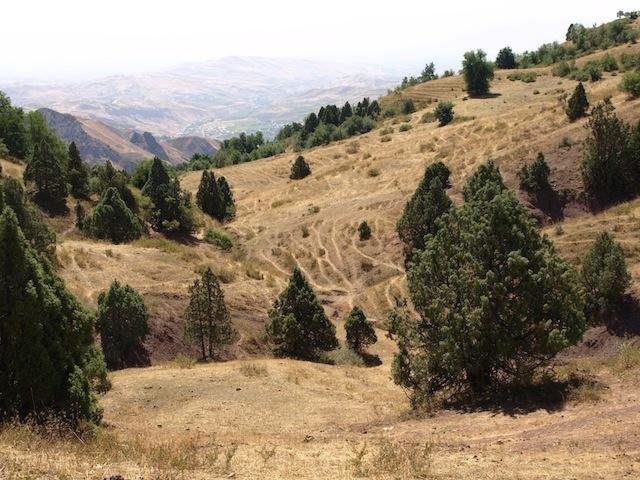
Sustainable managements on pasture and forest lands based … [ប្រទេសតាហ្ស៊ីគីស្ថាន]
Sustainable managements on pasture and forest lands based on natural regeneration by electrified fences
- អ្នកចងក្រង៖ Kakubari Yochitaka

Afforestation/Tree planting [អ៊ូហ្គង់ដា]
Tree planting carried out by individual land users on hilly slopes to improve soil cover ,reduce wind strength , provide wood fuel & household income.
- អ្នកចងក្រង៖ Wilson Bamwerinde
2. ការពណ៌នាពីបច្ចេកទេស SLM
2.1 ការពណ៌នាដោយសង្ខេបពីបច្ចេកទេស
និយមន័យបច្ចេកទេស:
Afforestation is a key technologies to protect soil against erosion and provide a wide range of ecosystem services. In this case, afforestation at high altitudes, which is particularly challenging, with the primary purpose of erosion control were planted in small patches with different methods. They form the basis for future community forests in Armenia.
2.2 ការពណ៌នាលម្អិតពីបច្ចេកទេស
ការពណ៌នា:
Forests are - in terms of biomass accumulation and stability - the most successful ecosystems in the world. Natural forest ecosystems offer multiple ecosystem services, such as timber and fuel wood provision, water purification, carbon sequestration. In mountainous landscapes, forests have an additional protective function against erosion and natural hazards (e.g., avalanches, landslides, debris flows or rock falls). In the South Caucasus, two natural limits restrict forest expansion: at 2.300-2.600m a.s.l. the upper tree line is visible, whereas steppe and semi-desert ecosystems form the lower tree line.
Socio-economic and geo-physical living conditions:
The intervention area is located at the northern to eastern slopes of Mount Aragats (4013m). The villages are located at 1600 to 1800 m above sea level where the slope meets a plain with stepic soils and crop production while the slopes of the mountains are used for livestock grazing (sheep and cattle).
Purpose of afforestation:
By means of afforestation of degraded pastures, mountainous areas that suffer from erosion and overgrazing should be rehabilitated and erosion protection capacity enhanced. At the same time, the afforestation sites should form the basis for future community forests providing a wide range of ecosystem services, a concept that has not yet been established in Armenia.
Implementation
Between 2014 and 2017 more than 200 hectares were fenced for afforestation, 145 ha were actively afforested in 10 different communities around Mount Aragats in Armenia. The average size of the 20 plots is 10 ha (35 ha being the largest site, 1 ha the smallest one).
The afforestation included different species combinations, planting schemes and methods to determine most cost-efficient afforestation methods for Armenian conditions. All afforestation took place at elevations between 1900 and 2300 m.a.s.l.. The afforestation included fencing of the area to protect the afforestation site against grazing, the preparation of the planting sites according to fixed planting schemes, the actual planting in lines with trenches, single plant holes and group plantings. For some sites, additional irrigation was established for the first years. Particular attention was paid to the species selection which explicitly included fruit trees and shrubs to ensure local economic returns.
Practical experiences
A wide range species was tested. Within the given climate context, pine (Pinus sylvestris), the main non-native species as well as native maple (Acer trautvetteri), Persian Oak (Quercus macranthera) and birch (Betula litwinowii) showed the best results. Particular attention was paid to adapted species to create resilient forest-shrubland with a large number of tree species. In general, planting in trenches shows highest survival rates. Bare root system and containerized seedlings were used for planting. Containerized seedlings definitely provide better survival rate in comparison with bare root system seedlings. Additionally, mulch cover was provided to protect seedlings and keep soil humidity. The main maintenance measures are repeated mulching and weed control and irrigation during the first 3 years. Furthermore, some replanting is continuously taking place as the sites are facing tough environmental conditions (hot summers, drought, short vegetation period).
The plantation was organised and supervised by local NGO's (ATP Armenian Tree Project, ESAC Environmental Sustainability Assistance Center) in close cooperation with the local village population. In a Memorandum of Understandig between the Armenian Ministry of Territorial Administration and Development, the local village administration and GIZ the share of payed labour and own contribution was fixed beforehand.
Impacts and perception
After the first years already first successes are becoming visible contributing to increased vegetation cover, increased biomass and improved soil protection. The communities are proud to be amongst the first in Armenia with a community forest. However, slow growth will require continuous commitment and care on behalf of the community.
2.3 រូបភាពនៃបច្ចេកទេស
2.4 វីដេអូនៃបច្ចេកទេស
ការពណ៌នាសង្ខេប:
Short video of ESAC, the implementing NGO, on afforestation background and techniques
https://www.youtube.com/watch?v=cLZ5ucDDclI
កាលបរិច្ឆេទ:
28/10/2018
ទីតាំង:
Aragatsotn and Shirak Marzes
ឈ្មោះអ្នកថតវីឌីអូ:
ESAC NGO (Khachatur Khachtryan)
ការពណ៌នាសង្ខេប:
Short video of ESAC, the implementing NGO on different fencing techniques used for protecting the afforestation sites
https://www.youtube.com/watch?v=INRnvnkYzCE
កាលបរិច្ឆេទ:
28/03/2018
ទីតាំង:
Aragatsotn and Shirak Marzes
ឈ្មោះអ្នកថតវីឌីអូ:
ESAC NGO (Khachatur Khachtryan)
2.5 ប្រទេស/តំបន់/ទីតាំងកន្លែង ដែលបច្ចេកទេសត្រូវបានអនុវត្ត និងបានគ្រប់ដណ្តប់ដោយការវាយតម្លៃនេះ
ប្រទេស:
ប្រទេសអាមេនី
តំបន់/រដ្ឋ/ខេត្ត:
Shirak and Aragatsotn Marzes
បញ្ជាក់បន្ថែមពីលក្ខណៈនៃទីតាំង:
Lusagyugh, Saralanj, Harich, Arayi, Quchak, Hnaberd, Mets Manatash, Pokr Mantash, Nahapetavan
មតិយោបល់:
Differerent small afforestation plots between 1 and 30 ha with a total of approximately 200 ha
Map
×2.6 កាលបរិច្ឆេទនៃការអនុវត្ត
ប្រសិនបើមិនច្បាស់ឆ្នាំ សូមបញ្ជាក់កាលបរិច្ឆេទដែលប្រហាក់ប្រហែល:
- តិចជាង 10ឆ្នាំមុន (ថ្មី)
2.7 ការណែនាំពីបច្ចេកទេស
សូមបញ្ជាក់តើបច្ចេកទេសត្រូវបានណែនាំឱ្យអនុវត្តដោយរបៀបណា:
- តាមរយៈគម្រោង / អន្តរាគមន៍ពីខាងក្រៅ
មតិយោបល់ (ប្រភេទនៃគម្រោង ។ល។):
This project introduced community-managed forests for erosion control to different communities. Different planting techniques and species were piloted to identify most appropriate afforestation and management methods.
3. ចំណាត់ថ្នាក់នៃបច្ចេកទេស SLM
3.1 គោលបំណងចម្បង (១ ឬច្រើន) នៃបច្ចេកទេសនេះ
- កាត់បន្ថយ, បង្ការ, ស្តារឡើងវិញនូវការធ្លាក់ចុះគុណភាពដី
- អភិរក្សប្រព័ន្ធអេកូឡូស៊ី
- អភិរក្ស/ធ្វើឱ្យប្រសើរឡើងជីវចម្រុះ
- កាត់បន្ថយការប្រែប្រួលអាកាសធាតុ និងផលប៉ះពាល់របស់វា
3.2 ប្រភេទដីប្រើប្រាស់មួយប្រភេទ (ច្រើនប្រភេទ) ដែលបានអនុវត្តបច្ចេកទេស

ដីសម្រាប់ចិញ្ចឹមសត្វ
ដីវាលស្មៅធំៗ:
- ពាក់កណ្តាលពនេចរ
ប្រភេទសត្វ និងផលិតផលចម្បងៗ:
Cattle and sheep

ដីព្រៃ/ដីដាំដើមឈើ
ការដាំដើមឈើ ការដាំព្រៃឡើងវិញ:
- ពូជបញ្ចូលគ្នា
ផលិតផល និងសេវាកម្ម:
- អុស
- ផ្លែឈើ និងគ្រាប់ធញ្ញជាតិ
- វាលស្មៅ
- ការពារពីគ្រោះធម្មជាតិ
ប្រសិនបើដីមានការប្រែប្រួលបន្ទាប់ពីការអនុវត្តបច្ចេកទេស សូមបញ្ជាក់ពីការប្រើប្រាស់ដីមុនពេលអនុវត្តន៍បច្ចេកទេស:
The afforestation sites were previously used as (partly overgrazed) pastures for grazing of mainly cattle. Thus, this technology included a land-use change from grassland/pasture to forest/shrubland.
3.3 ព័ត៌មានបន្ថែមអំពីអ្នកប្រើប្រាស់ដី
ការផ្គត់ផ្គង់ទឹកនៅកន្លែងអនុវត្តបច្ចេកទេស:
- ទឹកភ្លៀង និងប្រព័ន្ធស្រោចស្រព
ចំនួនសារដែលដាំដំណាំក្នុងមួយឆ្នាំ:
- 1
ដង់ស៊ីតេនៃសត្វចិញ្ចឹម (បើពាក់ព័ន្ធ):
1-2/ha
3.4 ក្រុម SLM ដែលបច្ចេកទេសស្ថិតនៅក្នុង
- ការគ្រប់គ្រងព្រៃធម្មជាតិ និងព្រៃពាក់កណ្តាលធម្មជាតិ
- តំបន់ទ្រនាប់ (បិទការប្រើប្រាស់ គាំទ្រដល់ការស្តារឡើងវិញ)
- កាត់បន្ថយហានិភ័យនៃបញ្ហាលើប្រព័ន្ធអេកូឡូស៊ី
3.5 ការសាយភាយនៃបច្ចេកទេស
បញ្ជាក់ពីការសាយភាយនៃបច្ចេកទេស:
- ត្រូវបានផ្សព្វផ្សាយត្រឹមតំបន់មួយ
ប្រសិនបើបច្ចេកទេសត្រូវបានសាយភាយពាសពេញតំបន់ណាមួយ សូមកំណត់ទំហំផ្ទៃដីអនុវត្តន៍:
- < 0.1 គម2 (10 ហិកតា)
មតិយោបល់:
Individual sites vary between 1 and 35 ha with a total area covered of 200 ha (2 km²) . However, it showed that communities only have the capacity to maintain a maximum size of 10 ha (maintenance). If managed by the community, it should not be larger.
3.6 វិធានការ SLM ដែលបញ្ចូលនូវបច្ចេកទេស

វិធានការរុក្ខជាតិ
- V1: ឈើធំៗ និងដើមឈើតូចៗ

វិធានការគ្រប់គ្រង
- M1: ការផ្លាស់ប្តូរប្រភេទដីប្រើប្រាស់
3.7 កំណត់ប្រភេទនៃការធ្លាក់ចុះគុណភាពដីសំខាន់ៗដែលបច្ចេកទេសនេះបានដោះស្រាយ

ការហូរច្រោះដីដោយសារទឹក
- Wt: ការបាត់ដីស្រទាប់លើដោយការហូរច្រោះ
- Wg: ការកកើតឡើងនូវកំទេចកំទីដីស្រទាប់ក្រោម

ការធ្លាក់ចុះជីវសាស្ត្រនៃដី
- Bc: ការថយចុះនូវគម្របរុក្ខជាតិ
- Bs: សមាសភាពដែលមានគុណភាពនិងប្រភេទសត្វ/ការថយចុះនូវជីវចម្រុះ
3.8 ការពារ កាត់បន្ថយ ឬស្តារឡើងវិញនៃការធ្លាក់ចុះគុណភាពដី
បញ្ជាក់ពីគោលដៅរបស់បច្ចេកទេស ដែលផ្តោតទៅការធ្លាក់ចុះគុណភាពដី:
- ការការពារការធ្លាក់ចុះគុណភាពដី
- ការកាត់បន្ថយការធ្លាក់ចុះគុណភាពដី
4. បច្ចេកទេសជាក់លាក់ សកម្មភាពអនុវត្ត ធាតុចូល និងថ្លៃដើម
4.1 គំនូសបច្ចេកទេសនៃបច្ចេកទេសនេះ
4.2 លក្ខណៈពិសេសនៃបច្ចេកទេស/ ពណ៌នាពីគំនូរបច្ចេកទេស
Needed resources for 1 ha afforestation:
- 2.000-5.000 seedlings
- 10-50 t water (for initial irrigation)
- 40 – 100 working days
- Shuffles or soil driller
- Means of transport
Selection of species
It is recommended to use different local tree species for any afforestation activity, as they can cope best with the given environmental conditions and, therefore, are more resilient towards pests and climatic variations. Most suitable species for afforestation:
-Trautvetters maple (Acer trautvetteri)
-Birch (Betula letwinowii)
-Wild Oriental Apple (Malus orientalis)
-Scott’s Pine (Pinus sylvestris var. hamata)
-Persian Oak (Quercus macranthera)
-Raspberry (Rubus idaeus)
-Mountain ash (Sorbus aucuparia)
For selecting suitable species, screening of the wider project area is essential in order to prepare a list of species, which would naturally grow under the given ecological conditions
Planting scheme
The technical drawings describe different potential planting schemes. A further figure describes the advantages and disadvantages of each scheme.
Planting season
The climate in the South Caucasus region shows low precipitation rates in the summer period. As seedlings have a small root system, young trees are more sensitive to drought. The best time for planting is either autumn or early spring as during autumn, winter and spring, more moisture is available that helps the seedlings to develop deeper root systems to survive during summer droughts.
Fencing
In many cases, afforestation sites are located on pasture land. To protect the planted seedlings from browsing by livestock or wild game, it is recommended to fence the afforestation site before starting the plantation of the seedlings.
Planting
The planting process is specified in one of the technical drawings. With a hole driller planting of one tree takes 2-4 minutes, planting by hand 8-10 min. Each seedling is waterered with an intial 5-10 l of water.
4.3 ព័ត៌មានទូទៅដែលពាក់ព័ន្ធនឹងការគណនាធាតុចូល និងថ្លៃដើម
កំណត់របៀបនៃការគណនាថ្លៃដើម និងធាតុចូល:
- ក្នុងតំបន់អនុវត្តបច្ចេកទេស
កំណត់ទំហំ និងឯកត្តាផ្ទៃដី:
1 ha
កំណត់រូបិយប័ណ្ណសម្រាប់ថ្លៃដើម:
- ដុល្លារអាមេរិក
4.4 សកម្មភាពបង្កើត
| សកម្មភាព | ប្រភេទវិធានការ | ពេលវេលា | |
|---|---|---|---|
| 1. | Selection of afforestation site, plantation scheme and species | ការគ្រប់គ្រង | anytime |
| 2. | Fencing of the area (if area is being grazed or wild game is browsing seedlings | រចនាសម្ព័ន្ធ | before planting |
| 3. | Prepare and transfer seedlings to the site | ការគ្រប់គ្រង | before planting |
| 4. | Excavate whole for the seedling (30-40cm deep, 25 cm diameter, 1m spacing between wholes) | រចនាសម្ព័ន្ធ | autumn, early spring |
| 5. | Place the seedling and fill hole with soil | សារពើរុក្ខជាតិ | autumn, early spring |
| 6. | Apply 5-10 l of water immediately after planting | ការគ្រប់គ្រង | after planting |
| 7. | Cover soil around seedling with mulch and organic material | សារពើរុក្ខជាតិ | after planting |
4.5 ថ្លៃដើម និងធាតុចូលដែលត្រូវការសម្រាប់ការបង្កើតបច្ចេកទេស
| បញ្ជាក់ពីធាតុចូល | ឯកតា | បរិមាណ | ថ្លៃដើមក្នុងមួយឯកតា | ថ្លៃធាតុចូលសរុប | % នៃថ្លៃដើមដែលចំណាយដោយអ្នកប្រើប្រាស់ដី | |
|---|---|---|---|---|---|---|
| កម្លាំងពលកម្ម | Local workers for plantation of trees | seedlings | 2500,0 | 0,27 | 675,0 | 10,0 |
| កម្លាំងពលកម្ម | Installation of fence and posts | person day | 191,0 | 12,3 | 2349,3 | |
| សម្ភារៈ | Equipment (hummer, driller, etc.) | set | 1,0 | 141,8 | 141,8 | 30,0 |
| សម្ភារៈដាំដុះ | Tree seedlings | pieces | 2500,0 | 0,31 | 775,0 | |
| សម្ភារៈដាំដុះ | Mulching | kg | 1250,0 | 0,03 | 37,5 | |
| សម្ភារៈសាងសង់ | Fencing (permanent mesh wire fence) | meter | 317,0 | 1,35 | 427,95 | 10,0 |
| សម្ភារៈសាងសង់ | Irrigation system | set | 1,0 | 889,0 | 889,0 | 15,0 |
| សម្ភារៈសាងសង់ | Metal posts for fence (1.8m) | pieces | 106,0 | 2,97 | 314,82 | |
| សម្ភារៈសាងសង់ | sand | kg | 3444,0 | 0,012 | 41,33 | |
| សម្ភារៈសាងសង់ | Other material(electrode, wire armature, metal disc) | set | 1,0 | 386,9 | 386,9 | 20,0 |
| សម្ភារៈសាងសង់ | Cement | kg | 1148,0 | 0,12 | 137,76 | |
| ផ្សេងៗ | Transporation of mulch | time | 1,0 | 102,8 | 102,8 | |
| ផ្សេងៗ | Transporation of construction materials | time | 5,0 | 92,5 | 462,5 | |
| ផ្សេងៗ | Transporation of workers to the field | time | 15,0 | 30,2 | 453,0 | |
| ផ្សេងៗ | Transporation of seedlings | time | 1,0 | 51,4 | 51,4 | |
| ថ្លៃដើមសរុបក្នុងការបង្កើតបច្ចេកទេស | 7246,06 | |||||
ប្រសិនបើអ្នកប្រើប្រាស់ដីមិនមានថ្លៃដើម 100% សូមបញ្ជាក់ថានរណាដែលចំណាយថ្លៃដើមដែលនៅសល់:
GIZ Project
មតិយោបល់:
The above calculation is not made on purely 1 ha, since the project did not implement afforestation on 1 ha. This calculation was done on 2.6 ha, then the costs are proportionally distributed for 1 ha.
4.6 សកម្មភាពថែទាំ
| សកម្មភាព | ប្រភេទវិធានការ | ពេលវេលា/ ភាពញឹកញាប់ | |
|---|---|---|---|
| 1. | Irrigation of young seedlings with 5-10 l | ការគ្រប់គ្រង | 2-4 times per year for the first two years |
| 2. | Preparation of fire protection trenches | រចនាសម្ព័ន្ធ | if needed |
| 3. | Mowing to prevent overgrowth of seedlings | សារពើរុក្ខជាតិ | 1-2 times per year |
| 4. | Renew mulch layer | ការគ្រប់គ្រង | annually after hay harvest in summer |
| 5. | Replanting of seedlings (10% each year) | ការគ្រប់គ្រង | annually to be done for the first 5 years |
4.7 កំណត់ថ្លៃដើមសម្រាប់ការថែទាំ/ សកម្មភាពរបស់បច្ចេកទេស (ក្នុងរយៈពេលមួយឆ្នាំ)
| បញ្ជាក់ពីធាតុចូល | ឯកតា | បរិមាណ | ថ្លៃដើមក្នុងមួយឯកតា | ថ្លៃធាតុចូលសរុប | % នៃថ្លៃដើមដែលចំណាយដោយអ្នកប្រើប្រាស់ដី | |
|---|---|---|---|---|---|---|
| កម្លាំងពលកម្ម | Irrigation of young seedlings with 5-10 l | Man/day | 1,0 | 10,0 | 10,0 | 100,0 |
| កម្លាំងពលកម្ម | Preparation of fire protection trenches | rm | 150,0 | 0,34 | 51,0 | 100,0 |
| កម្លាំងពលកម្ម | Mowing to prevent overgrowth of seedlings | Man/day | 4,0 | 10,0 | 40,0 | 50,0 |
| កម្លាំងពលកម្ម | Renew mulch layer (including mulch value) | Man/day | 5,0 | 10,0 | 50,0 | 50,0 |
| សម្ភារៈដាំដុះ | Seedlings for replantation (including labour) | seedlings | 1200,0 | 0,51 | 612,0 | 50,0 |
| ផ្សេងៗ | Petrol for irrigation | liter | 7,0 | 0,8 | 5,6 | |
| ថ្លៃដើមសរុបសម្រាប់ការថែទាំដំណាំតាមបច្ចេកទេស | 768,6 | |||||
ប្រសិនបើអ្នកប្រើប្រាស់ដីមិនមានថ្លៃដើម 100% សូមបញ្ជាក់ថានរណាដែលចំណាយថ្លៃដើមដែលនៅសល់:
GIZ project
មតិយោបល់:
The rather high costs are mostly linked to the permanent fence to protect seedlings against grazing and to high number of seedlings per hectare. In some parts initial irrigation was necessary due to dry summer conditions. Maintenance activities such as irrigation of seedlings in summer, anti-fire measures, replantation of seedlings (10 % each year for 5 years), mowing of grass and renewing of mulch layer are needed.
4.8 កត្តាសំខាន់បំផុតដែលមានឥទ្ធិពលដល់ការចំណាយ
ពណ៌នាពីកត្តាប៉ះពាល់ចម្បងៗទៅលើថ្លៃដើម:
With costs of approximately 5,700 USD/ha including fencing (30%), planting (30%) and seedlings (40%) afforestation is very intensive in financial resources. It is very likely that these high costs will limit the upscaling of the afforestation process. There are some options to reduce costs:
•Fence large areas and try to have sites in square or circle shape
•Increase number of seedlings planted by person by using soil-drillers
•Use cheaper fencing material (e.g. game protection fence, poles without concrete)
•Reduce seedling number to 2000-3000 seedlings/ha
•Using seeds (e.g. oak) instead of seedlings
•Regrow seeds in local low-cost nurseries (e.g. Lusagyugh)
5. លក្ខណៈបរិស្ថានធម្មជាតិ និងមនុស្ស
5.1 អាកាសធាតុ
បរិមាណទឹកភ្លៀងប្រចាំឆ្នាំ
- < 250 មម
- 251-500 មម
- 501-750 មម
- 751-1,000 មម
- 1,001-1,500 មម
- 1,501-2,000 មម
- 2,001-3,000 មម
- 3,001-4,000 មម
- > 4,000 មម
កំណត់បរិមាណទឹកភ្លៀង (បើដឹង) ជា មីលីម៉ែត្រ:
521,00
លក្ខណៈពិសេស/ មតិយោបល់លើរដូវភ្លៀង:
Precipitation peak between May and June.
បញ្ជាក់ឈ្មោះឯកសារយោងនៃស្ថានីយឧតុនិយម:
Aparan, Aragatsotn Marz, Armenia
តំបន់កសិអាកាសធាតុ
- មានភ្លៀងតិចតួច
According to Köppen and Geiger, the climate is classified as Dfb (Cold/continental, no dry season, warm summers). Annual mean temperature is 5.2. °C. The warmest month of the year is August, with an average temperature of 16.4 °C. January has the lowest average temperature of the year with -6.9 °C.
based on data from the following source: https://www.arcgis.com/home/webmap/viewer.html?layers=3ac478a468c245ef9bfd5533f7edbf93
5.2 សណ្ឋានដី
ជម្រាលជាមធ្យម:
- រាបស្មើ (0-2%)
- ជម្រាលតិចតួច (3-5%)
- មធ្យម (6-10%)
- ជម្រាលខ្ពស់បន្តិច (11-15%)
- ទីទួល (16-30%)
- ទីទួលចោត (31-60%)
- ទីទួលចោតខ្លាំង (>60%)
ទម្រង់ដី:
- ខ្ពង់រាប
- កំពូលភ្នំ
- ជម្រាលភ្នំ
- ជម្រាលទួល
- ជម្រាលជើងភ្នំ
- បាតជ្រលងភ្នំ
តំបន់តាមរយៈកម្ពស់ :
- 0-100 ម
- 101-500 ម
- 501-1,000 ម
- 1,001-1,500 ម
- 1,501-2,000 ម
- 2,001-2,500 ម
- 2,501-3,000 ម
- 3,001-4,000 ម
- > 4,000 ម
បញ្ជាក់ថាតើបច្ចេកទេសនេះត្រូវបានអនុវត្តន៍នៅក្នុង:
- មិនពាក់ព័ន្ធទាំងអស់
5.3 ដី
ជម្រៅដីជាមធ្យម:
- រាក់ខ្លាំង (0-20 សម)
- រាក់ (21-50 សម)
- មធ្យម (51-80 សម)
- ជ្រៅ (81-120 សម)
- ជ្រៅខ្លាំង (> 120 សម)
វាយនភាពដី (ស្រទាប់លើ):
- មធ្យម (ល្បាយ, ល្បាប់)
វាយនភាពដី (> 20 សម ស្រទាប់ក្នុង):
- មធ្យម (ល្បាយ, ល្បាប់)
សារធាតុសរីរាង្គនៅស្រទាប់ដីខាងលើ:
- មធ្យម (1-3%)
5.4 ទឹកដែលអាចទាញមកប្រើប្រាស់បាន និងគុណភាពទឹក
នីវ៉ូទឹកក្រោមដី:
5-50 ម
ទឹកលើដីដែលអាចទាញយកប្រើប្រាស់បាន:
កម្រិតមធ្យម
គុណភាពទឹក (មិនបានធ្វើប្រត្តិកម្ម):
ទឹកពិសារដែលគ្មានគុណភាព (តម្រូវឱ្យមានការសំអាត)
តើមានបញ្ហាភាពទឹកប្រៃហូរចូលមកដែរឬទេ?
ទេ
តើទឹកជំនន់កំពុងកើតមាននៅតំបន់នេះដែររឺទេ?
ទេ
5.5 ជីវៈចម្រុះ
ភាពសម្បូរបែបនៃប្រភេទ:
- កម្រិតមធ្យម
ភាពសម្បូរបែបនៃទីជម្រក:
- ទាប
5.6 លក្ខណៈនៃអ្នកប្រើប្រាស់ដីដែលអនុវត្តបច្ចេកទេស
នៅមួយកន្លែង ឬពនេចរ :
- នៅមួយកន្លែង
ទីផ្សារនៃប្រព័ន្ធផលិតកម្ម:
- ពាក់កណ្តាលពាណិជ្ជកម្ម (ផ្គត់ផ្គង់ខ្លួនឯង/ ពាណិជ្ជកម្ម
ចំណូលក្រៅកសិកម្ម:
- 10-50% នៃចំណូល
កម្រិតជីវភាព:
- មិនល្អ
- មធ្យម
ឯកជន ឬក្រុម:
- ជាក្រុម/ សហគមន៍
- សហករ
កម្រិតប្រើប្រាស់គ្រឿងយន្ត:
- ប្រើកម្លាំងពលកម្ម
- គ្រឿងយន្ត/ ម៉ាស៊ីន
យេនឌ័រ:
- ស្ត្រី
- បុរស
អាយុរបស់អ្នកប្រើប្រាស់ដី:
- វ័យកណ្តាល
- មនុស្សចាស់
5.7 ទំហំផ្ទៃដីជាមធ្យមនៃដីផ្ទាល់ខ្លួន ឬជួលគេដែលបានអនុវត្តបច្ចេកទេស
- < 0.5 ហិកតា
- 0.5-1 ហិកតា
- 1-2 ហិកតា
- 2-5 ហិកតា
- 5-15 ហិកតា
- 15-50 ហិកតា
- 50-100 ហិកតា
- 100-500 ហិកតា
- 500-1,000 ហិកតា
- 1,000-10,000 ហិកតា
- > 10,000 ហិកតា
តើផ្ទៃដីនេះចាត់ទុកជាទំហំកម្រិតណាដែរ ខ្នាតតូច មធ្យម ឬខ្នាតធំ (ធៀបនឹងបរិបទតំបន់)?
- ខ្នាតតូច
5.8 ភាពជាម្ចាស់ដី កម្មសិទ្ធប្រើប្រាស់ដី និងកម្មសិទ្ធប្រើប្រាស់ទឹក
ភាពជាម្ចាស់ដី:
- ភូមិ
កម្មសិទ្ធិប្រើប្រាស់ដី:
- ជាក្រុម (មានដែនកំណត់)
កម្មសិទ្ធប្រើប្រាស់ទឹក:
- ជាក្រុម (មានដែនកំណត់)
5.9 ការប្រើប្រាស់សេវាកម្ម និងហេដ្ឋារចនាសម្ព័ន្ធ
សុខភាព:
- មិនល្អ
- មធ្យម
- ល្អ
ការអប់រំ:
- មិនល្អ
- មធ្យម
- ល្អ
ជំនួយបច្ចេកទេស:
- មិនល្អ
- មធ្យម
- ល្អ
ការងារ (ឧ. ការងារក្រៅកសិដ្ឋាន):
- មិនល្អ
- មធ្យម
- ល្អ
ទីផ្សារ:
- មិនល្អ
- មធ្យម
- ល្អ
ថាមពល:
- មិនល្អ
- មធ្យម
- ល្អ
ផ្លូវ និងការដឹកជញ្ជូន:
- មិនល្អ
- មធ្យម
- ល្អ
ទឹកផឹក និងអនាម័យ:
- មិនល្អ
- មធ្យម
- ល្អ
សេវាកម្មហិរញ្ញវត្ថុ:
- មិនល្អ
- មធ្យម
- ល្អ
6. ផលប៉ះពាល់ និងការសន្និដ្ឋាន
6.1 ផលប៉ះពាល់ក្នុងបរិវេណអនុវត្តបច្ចេកទេសដែលកើតមាន
ផលប៉ះពាល់លើសេដ្ឋកិច្ចសង្គម
ផលិតផល
ផលិតកម្មចំណីសត្វ
មតិយោបល់/ ការបញ្ជាក់:
Within the fenced afforestation site, the grass could be cut and used as hay. The protection from grazing helps biomass development which leads to better protection from Surface water Erosion and this lead to soil-regeneration and increase of productivity.
គុណភាពព្រៃឈើ/ដីព្រៃ
មតិយោបល់/ ការបញ្ជាក់:
The natural forest was removed for the purpose of grazing and the forest cover will be now re-established on the afforestation sites.
អនុផលព្រៃឈើ
មតិយោបល់/ ការបញ្ជាក់:
We mixed shrub species like raspberries and fruit-trees (wilde plumb) between the main tree species to create short time Benefit for the village people.
ភាពសម្បូរបែបនៃផលិតផល
មតិយោបល់/ ការបញ្ជាក់:
In addition to the wide spread grazing land use now the hay production in the fenced afforestation site is increased for the first 1-2 decades (until the canopy is too dense) and the collection of berries and fruits give additional income opportunities. In the Long terme fuel wood production can be expected from the forested land.
ផ្ទៃដីផលិតកម្ម
មតិយោបល់/ ការបញ្ជាក់:
The grazing range is limited by the fenced afforestation site. This is relevant in the first couple of years before hay or fruit/berry productivity is able to fully compensate the loss of grazing range.
ចំណូល និងថ្លៃដើម
បន្ទុកការងារ
មតិយោបល់/ ការបញ្ជាក់:
The maintenance of the afforestation site lead to increase of workload especially in the first 2-4 years when hay cutting and Irrigation is needed until the tree seedlings are well established.
ផលប៉ះពាល់ទៅលើវប្បធម៌សង្គម
ឱកាសនៃការបង្កើតថ្មី
មតិយោបល់/ ការបញ្ជាក់:
As there is almost no forest near to the villages every woodland is very attractive for recreational purpose, but it will Need 2-3 decades until this function will be fulfilled by the afforestation site.
ចំណេះដឹង SLM / ការធ្លាក់ចុះគុណភាពដី
មតិយោបល់/ ការបញ្ជាក់:
The local stakeholders got hands on training on fencing, afforestation and maintenance of afforestation sites.
ផលប៉ះពាល់ទៅលើអេកូឡូស៊ី
វដ្តទឹក/លំហូរ
លំហូរទឹកលើផ្ទៃដី
មតិយោបល់/ ការបញ្ជាក់:
The fencing of the afforestation site immediately stops the heavy grazing Impact which leads to fast recovery of the Vegetation. The improved Vegetation cover and better development of the root System reduce Surface water run of Speed and increase water Infiltration.
រំហួត
មតិយោបល់/ ការបញ្ជាក់:
An increase of vegetation and the leaf area index will lead to an increase of evaporation.
ដី
ការបាត់បង់ដី
មតិយោបល់/ ការបញ្ជាក់:
Increase of vegetation cover and reduction of water runoff will lead to decrease of soil loss.
សារធាតុសរីរាង្គដី/ការបូនក្រោមដី
មតិយោបល់/ ការបញ្ជាក់:
The increase of vegetation leads to an increase of root development. Additionally, the increase of vegetation produces more litter, as no grazing is applied. The increase in litter leads to an increase of an humus layer and therefore to more below ground carbon.
ជីវចម្រុះ៖ ដំណាំ, សត្វ
ដំណាំគម្រប
មតិយោបល់/ ការបញ្ជាក់:
Especially the fencing leads to fast increase of vegetation cover.
ជីវម៉ាស/ កាបូនលើដី
មតិយោបល់/ ការបញ្ជាក់:
The local stakeholders got hands on training on fencing, afforestation and maintenance of afforestation sites.
ភាពសម្បូរបែបនៃរុក្ខជាតិ
មតិយោបល់/ ការបញ្ជាក់:
The stop of grazing and the new micro-habitats created by the shadow of the tree seedlings have let to an increase in plant diversity. This process might be reverse when the tree canopy is closed and less light is available for the herb-layer, but this will take several decades.
ភាពសម្បូរបែបនៃទីជំរក
មតិយោបល់/ ការបញ្ជាក់:
The plain grasslands habitats are diversified by patches of forest.
6.2 ផលប៉ះពាល់ក្រៅបរិវេណអនុវត្តបច្ចេកទេសដែលកើតមាន
Buffering/សមត្ថភាពចម្រោះ
មតិយោបល់/ ការបញ្ជាក់:
The decrease of water run off increase the water capacity of the habitat and the afforested area will provide increase buffer capacity in the case of intensive rainfalls.
ខ្យល់នាំយកនូវធូរលី
មតិយោបល់/ ការបញ្ជាក់:
The high grass and trees reduce wind speed at ground level.
បញ្ជាក់បន្ថែមការវាយតម្លៃផលប៉ះពាល់:
Most of the afforestation sites are locate uphill of villages. Village people are expecting protection from cold down-hill winds from the mountain and an increase of air-moisture by the evapo-transpiration of the forest.
6.3 ភាពប្រឈម និងភាពរួសនៃបច្ចេកទេសទៅនឹងការប្រែប្រួលអាកាសធាតុ និងគ្រោះអាកាសធាតុ/ គ្រោះមហន្តរាយ (ដែលដឹងដោយអ្នកប្រើប្រាស់ដី)
គ្រោះអាកាសធាតុ (មហន្តរាយ)
គ្រោះមហន្តរាយធម្មជាតិ
| លក្ខណៈឆ្លើយតបនៃបច្ចេកទេសទៅនឹងការប្រែប្រួលអាកាសធាតុ | |
|---|---|
| ព្យុះរន្ទះតាមតំបន់ | មធ្យម |
| ព្យុះទឹកកកតាមតំបន់ | មធ្យម |
| ព្យុះព្រិលតាមតំបន់ | ល្អ |
គ្រោះមហន្តរាយជីវៈសាស្ត្រ
| លក្ខណៈឆ្លើយតបនៃបច្ចេកទេសទៅនឹងការប្រែប្រួលអាកាសធាតុ | |
|---|---|
| ការមានបញ្ហាសត្វល្អិត/ដង្កូវ | មធ្យម |
ផលវិបាកដែលទាក់ទងនឹងបរិយាកាសផ្សេងៗទៀត
ផលវិបាកដែលទាក់ទងនឹងបរិយាកាសផ្សេងៗទៀត
| លក្ខណៈឆ្លើយតបនៃបច្ចេកទេសទៅនឹងការប្រែប្រួលអាកាសធាតុ | |
|---|---|
| អូសបន្លាយពេលដាំដុះ | ល្អ |
6.4 ការវិភាគថ្លៃដើម និងអត្ថប្រយោជន៍
តើផលចំណេញ និងថ្លៃដើមត្រូវបានប្រៀបធៀបគ្នាយ៉ាងដូចម្តេច (ទស្សនៈរបស់អ្នកប្រើប្រាស់ដី)?
រយៈពេលខ្លី:
អវិជ្ជមាន
រយៈពេលវែង:
វិជ្ជមានតិចតួច
តើផលចំណេញ និងការថែទាំ/ ជួសជុលត្រូវបានប្រៀបធៀបគ្នាយ៉ាងដូចម្តេច (ទស្សនៈរបស់អ្នកប្រើប្រាស់ដី)?
រយៈពេលខ្លី:
អវិជ្ជមានតិចតួច
រយៈពេលវែង:
វិជ្ជមាន
មតិយោបល់:
In the first decade the efforts on maintenance are high and it can be expected that the return of natural resources (hay, berries, fruits) is significantly lower the the maintenance efforts. As soon the trees are established and larger than 1.3 the root system is well establish and the trees are resistant to droughts, no vegetation cutting is needed and even game or cattle browsing will not necessarily lead to lethal damage.
6.5 ការទទួលយកបច្ចេកទេស
- តែមួយករណី /ពិសោធន៍
ក្នុងចំណោមគ្រួសារទាំងអស់ដែលអនុវត្តបច្ចេកទេស តើមានប៉ុន្មានគ្រួសារដែលចង់ធ្វើដោយខ្លួនឯង ដោយមិនទទួលបានសម្ភារៈលើកទឹកចិត្ត/ប្រាក់ឧបត្ថម្ភ?:
- 0-10%
6.6 ការបន្សុំា
តើថ្មីៗនេះ បច្ចេកទេសនេះត្រូវបានកែតម្រូវដើម្បីបន្ស៊ាំទៅនឹងស្ថានភាពប្រែប្រួលដែរឬទេ?
បាទ/ចា៎
បើឆ្លើយបាទ/ ចា៎ សូមកំណត់ថាតើស្ថានភាពប្រែប្រួលមួយណាត្រូវបានបន្ស៊ាំ:
- ការប្រែប្រួលអាកាសធាតុ/គ្រោះមហន្តរាយធម្មជាតិ
បញ្ជាក់ពីការបន្ស៊ាំនៃបច្ចេកទេស (ការរៀបចំ, ឧបករណ៍/ប្រភេទ ។ល។):
drought-adapted species, adaptation of planting schemes
6.7 ភាពខ្លាំង/ គុណសម្បត្តិ/ ឱកាសនៃបច្ចេកទេស
| ភាពខ្លាំង/ គុណសម្បត្តិ/ ឱកាសនៅកន្លែងរបស់អ្នកប្រើប្រាស់ដី |
|---|
| Extension of forest cover of communities, new habitat for wild creators, forest will be a fire wood and non timber products source for local inhabitants, attraction of tourists into the communities, increased water regulating function, improved soil quality, increased vegetation, microclimate formation function, wind velocity reduction, reduced land degradation, nice view of the area due to afforestation,increased fodder for cattle |
| empowerment of the local capacities on sustainable land management |
| successful demonstration of erosion control measures |
| ភាពខ្លាំង/ គុណសម្បត្តិ/ ឱកាស ទស្សនៈរបស់បុគ្គលសំខាន់ៗ |
|---|
| Diversification of land use options for local stakeholders. Future options for sustainable firewood supply, non-timber forests products (berries) and recreation |
| Option to use grass from cutting in between as fodder/hay production |
| side-effect of fencing is increase in biodiversity of grassland species due to exclusion from grazing. |
6.8 ភាពខ្សោយ/ គុណវិបត្តិ/ ហានិភ័យនៃបច្ចេកទេស និងវិធីសាស្ត្រដោះស្រាយ
| ភាពខ្សោយ/ គុណវិបត្តិ/ ហានិភ័យ ទស្សនៈរបស់អ្នកប្រើប្រាស់ដី | តើបច្ចេកទេសទាំងនោះបានដោះស្រាយបញ្ហាដូចម្តេច? |
|---|---|
| Reduces pasture land of community, which was converted into a forest | Villagers/farmers need to increase the amount of hay from their homestead gardens using irrigation |
| ភាពខ្សោយ/ គុណវិបត្តិ/ ហានិភ័យ ទស្សនៈរបស់អ្នកចងក្រងឬបុគ្គលសំខាន់ៗ | តើបច្ចេកទេសទាំងនោះបានដោះស្រាយបញ្ហាដូចម្តេច? |
|---|---|
| strong need for care taking in the first years | community commitment, strong ownership |
| Expensive due to high costs for fencing | Consider alternative, cheaper fencing methods (e.g. wildlife protection fence) |
| Complicated decision making processes by the project | More mandate given to the implementing NGOs |
7. ឯកសារយោង និងវេបសាយ
7.1 វិធីសាស្ត្រ/ ប្រភពនៃព័ត៌មាន
- តាមការចុះទីវាល ការស្រាវជ្រាវនៅទីវាល
- ការសម្ភាសន៍ជាមួយអ្នកប្រើប្រាស់ដី
- ការសម្ភាសន៍ជាមួយអ្នកជំនាញ/ ឯកទេស
2 international (Huber, Kirchmeir)
national?
- ការចងក្រងពីរបាកការណ៍ និងឯកសារផ្សេងៗទៀតដែលមាន
Information extracted from different project reports and submitted financial statements from implementation
7.2 ឯកសារយោងដែលបានចេញផ្សាយ
ចំណងជើង អ្នកនិពន្ធ ឆ្នាំ ISBN:
Handbook on Integrated Erosion Control A Practical Guide for Planning and Implementing Integrated Erosion Control Measures in Armenia, GIZ (ed.), 2018, ISBN 978-9939-1-0721-9
មានប្រភពមកពីណា? ថ្លៃដើមប៉ុន្មាន?
GIZ Armenia
7.3 ចូលទៅទាញយកឯកសារដែលពាក់ព័ន្ធតាមបណ្តាញអ៊ិនធឺណែត
ចំណងជើង/ ពណ៌នា:
Project website of the GIZ program
វេបសាយ:
http://biodivers-southcaucasus.org/
ការតភ្ជាប់ និងម៉ូឌុល
ពង្រីកមើលទាំងអស់ បង្រួមទាំងអស់ការតភ្ជាប់

Sustainable managements on pasture and forest lands based … [ប្រទេសតាហ្ស៊ីគីស្ថាន]
Sustainable managements on pasture and forest lands based on natural regeneration by electrified fences
- អ្នកចងក្រង៖ Kakubari Yochitaka

Afforestation/Tree planting [អ៊ូហ្គង់ដា]
Tree planting carried out by individual land users on hilly slopes to improve soil cover ,reduce wind strength , provide wood fuel & household income.
- អ្នកចងក្រង៖ Wilson Bamwerinde
ម៉ូឌុល
គ្មានម៉ូឌុល


